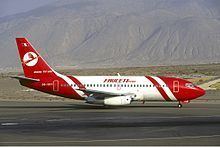Site Arequipa, Peru Aircraft type Boeing 737–222 Date 29 February 1996 Total fatalities 123 (all) Crew count 6 | Passengers 117 Registration OB-1451 Operator Faucett Perú Passenger count 117 | |
 | ||
Flight origin Jorge Chávez International Airport
Lima, Peru Stopover Rodríguez Ballón Int'l Airport
Arequipa, Peru Summary Controlled flight into terrain Similar 1996 Air Africa crash, ADC Airlines Flight 86, Vnukovo Airlines Flight 2801, Eastwind Airlines Flight 517, United Express Flight 5925 | ||
Faucett Flight 251 refers to a Boeing 737-200 that was operating a domestic scheduled Lima–Arequipa–Tacna passenger service and crashed on 29 February 1996, while completing the first leg, on approach to Rodríguez Ballón International Airport. All 123 passengers and crew aboard the aircraft lost their lives in the accident. It is the deadliest accident that occurred on Peruvian soil, as of March 2012.
Contents
Aircraft
The aircraft involved in the accident was a Boeing 737-222, tail number OB-1451, c/n 19072, that had its maiden flight on 21 October 1968. Equipped with Pratt & Whitney JT8D-7B engines, the airplane started its commercial career on 28 October 1968, when it was delivered new to United Airlines and registered N9034U. Re-registered N73714 on 14 June 1971, Aloha Airlines took possession of the airplane until late October 1980 (1980-10), when it was transferred to Air California with the same registration. Air California was rebranded AirCal in October 1981 (1981-10), and the aircraft was re-registered again to N459AC. Following the absorption of AirCal into American Airlines, the airplane continued its career with this carrier until Braniff Airways received it, with the same registration, on 2 March 1989, later going to AL AC 2 Corp, on 15 May 1990. Finally, the aircraft was delivered to Faucett on 15 July 1991, and registered OB-1451. The airframe was 7008863308800000000♠27 years and 131 days old at the time of the accident.
Description
Inbound from Jorge Chávez International Airport, the aircraft was on a DME approach to Rodríguez Ballón International Airport's runway 09, at night, in rain and mist, with thunderstorms reported in the area. The crew had been issued an outdated barometric altimeter setting after bypassing an ILS signal, causing them to fly almost 1,000 feet (300 m) lower than the altitude they believed they were flying at. In fact, they had the wrong impression the aircraft was flying at 9,500 feet (2,900 m), when it actually was at 8,640 feet (2,630 m), some 850 feet (260 m) below the glideslope. The flightcrew asked for the lights of the runway to be brightened as they could not see them when they should on normal approach, receiving a response from air traffic controllers that they were at full intensity. The airplane crashed into hills at 8,200 feet (2,500 m) —the airport elevation is 8,405 feet (2,562 m)—, at 20:25, approximately 2 kilometres (1.2 mi) short of the runway and 8 kilometres (5.0 mi) off Arequipa. The aft section broke off on impact, and the main fuselage section continued to fly past the initial ridge and impacted near the top of the second one. The tail section fell into a crevasse between the two ridges.
There were 123 people aboard the aircraft, of whom 117 were passengers. The nationalities of the victims were as follows:
